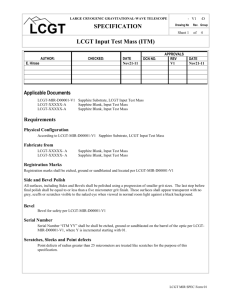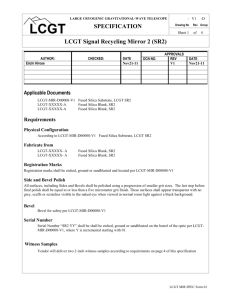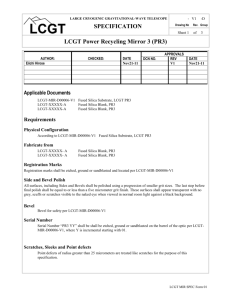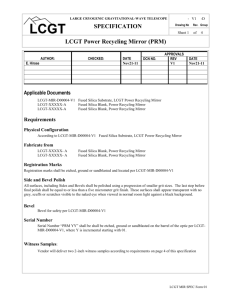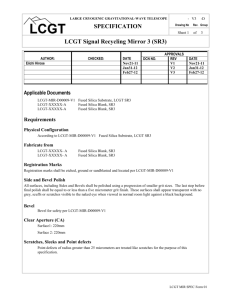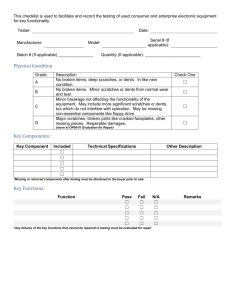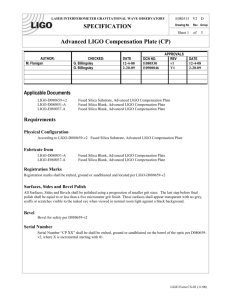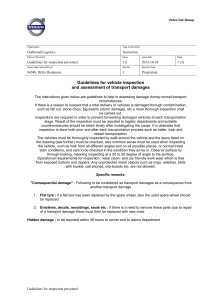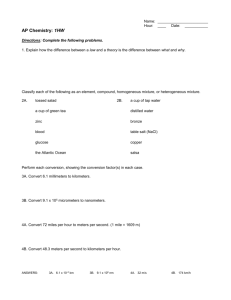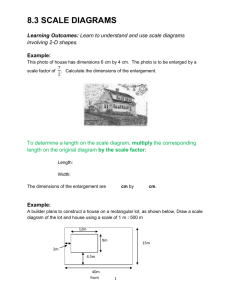ETM_Silica Spec
advertisement
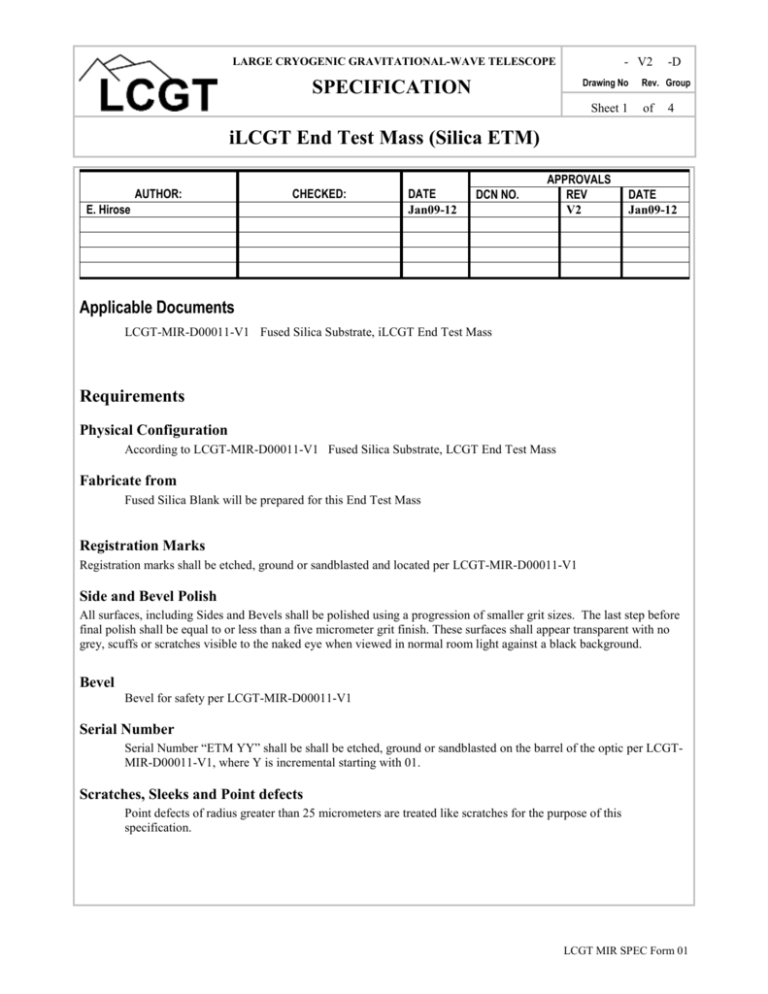
- V2 LARGE CRYOGENIC GRAVITATIONAL-WAVE TELESCOPE Drawing No SPECIFICATION Sheet 1 -D Rev. Group of 4 iLCGT End Test Mass (Silica ETM) AUTHOR: CHECKED: E. Hirose DATE Jan09-12 DCN NO. APPROVALS REV V2 DATE Jan09-12 Applicable Documents LCGT-MIR-D00011-V1 Fused Silica Substrate, iLCGT End Test Mass Requirements Physical Configuration According to LCGT-MIR-D00011-V1 Fused Silica Substrate, LCGT End Test Mass Fabricate from Fused Silica Blank will be prepared for this End Test Mass Registration Marks Registration marks shall be etched, ground or sandblasted and located per LCGT-MIR-D00011-V1 Side and Bevel Polish All surfaces, including Sides and Bevels shall be polished using a progression of smaller grit sizes. The last step before final polish shall be equal to or less than a five micrometer grit finish. These surfaces shall appear transparent with no grey, scuffs or scratches visible to the naked eye when viewed in normal room light against a black background. Bevel Bevel for safety per LCGT-MIR-D00011-V1 Serial Number Serial Number “ETM YY” shall be shall be etched, ground or sandblasted on the barrel of the optic per LCGTMIR-D00011-V1, where Y is incremental starting with 01. Scratches, Sleeks and Point defects Point defects of radius greater than 25 micrometers are treated like scratches for the purpose of this specification. LCGT MIR SPEC Form 01 - V2 LARGE CRYOGENIC GRAVITATIONAL-WAVE TELESCOPE Drawing No SPECIFICATION -D Rev. Group Sheet 2 of 4 iLCGT End Test Mass (Silica ETM) Scratches and Sleeks, Surface 1 3 The total area of scratches and sleeks within the central 100 mm diameter shall not exceed 20 X 10 square micrometers (width times length.) 3 The total area of scratches and sleeks outside the central 100 mm diameter shall not exceed 300 X 10 square micrometers (width times length.) Scratches and Sleeks, Surface 2 3 The total area of scratches and sleeks within the central 100 mm diameter shall not exceed 1000 X 10 square micrometers (width times length.) Point Defects, Surface 1 There shall be no more than 10 point defects of radius greater than 2 m within the central 100 mm diameter. There shall be no more than 100 point defects of radius greater than 2 m on the entire surface, inspected out to 210mm diameter. Average density of defects less than 2m radius must be less than or equal to 1 per 4mm2 Point Defects, Surface 2 There shall be no more than 100 point defects of radius greater than 2 m within the central 100 mm diameter Scratch and Point Defect Inspection Method 1. The surface is examined visually by two observers independently. The examination is done against a dark background using a fiber optic illumination system of at least 200 W total power. A 100% inspection of the surface is carried out. Pits and scratches down to 2 micrometers in width can be detected using this method of inspection. Any scratches or sleeks that are detected will be measured using a calibrated eyepiece. 2. Further inspection will be done with a minimum 6X eyeglass using the same illumination conditions, again with two observers. Sleeks down to 0.5 micrometers wide can be detected using this method. The surface will be scanned along one or two chords from centre to edge, then at ten positions around the edge, and ten to fifteen positions near the centre. 3. An inspection is then carried out with a dark or bright field microscope, with 5x objective at four positions at each of the following locations: a) Within 10mm of the center of the surface. b) Equally spaced along the circumference of a centered, 60 mm diameter circle. c) Equally spaced along the circumference of a centered, 120 mm diameter circle. Optical Surface Figure, measured over the central 220 mm diameter Surface 1: Spherical, concave. Radius of curvature: 7500.0 m -37.5, +37.5 m absolute accuracy ROC precision: R ± 3 m where 7462.5 m ≤ R ≤ 7537.5 m for both ETM optics Astigmatism: < 3 nm Amplitude of the Zernike coefficient Z as defined in Born and Wolf pp. 523-525. 2, 2 Surface 2: Nominally flat. ROC > |100km| LCGT MIR SPEC Form 01 - V2 LARGE CRYOGENIC GRAVITATIONAL-WAVE TELESCOPE SPECIFICATION Drawing No Sheet 3 -D Rev. Group of 4 iLCGT End Test Mass (Silica ETM) Surface Error, Low Spatial Frequency: measurement aperture to 1 mm-1 The following root mean square standard deviation (σ ) values are calculated from the phase maps which are rms to be provided with each optic. For this calculation the amplitudes for the best fit Zernike terms Z , Z , Z 0,0 and Z 2,2 1,1 2,0 or corresponding Seidel aberrations are subtracted from the phase map. Known bad pixels may be excluded from this calculation. -1 Surface 1, Frequency Band: < 1 mm Measured outside the central 140 mm diameter aperture: σ Measured over the central 140 mm diameter aperture: σ rms rms < 2.0nanometers < 0.5 nanometers -1 Surface 2 - Frequency Band: < 1 mm Measured on the entire surface: σ < 40 nanometers rms Measured over the central 140 mm diameter aperture: σ Error, High Spatial Frequency: 1– 750 mm Surface 1 HSF error σ rms rms < 2 nanometers -1 < 0.16 nanometers measured at the following locations: 1. Within 2mm of the center of the surface. 2. Four positions equally spaced along the circumference of a centered, 60 mm diameter circle. 3. Three positions equally spaced along the circumference of a centered, 120 mm diameter circle. Surface 2 HSF error σ rms < 2 nanometer measured at the following location: 1. Within 2mm of the center of the surface. 2. Four positions equally spaced along the circumference of a centered, 60 mm diameter circle. 3. Three positions equally spaced along the circumference of a centered, 120 mm diameter circle. LCGT MIR SPEC Form 01 - V2 LARGE CRYOGENIC GRAVITATIONAL-WAVE TELESCOPE Drawing No SPECIFICATION Sheet 4 -D Rev. Group of 4 iLCGT End Test Mass (Silica ETM) Inspection Table 1: Inspections Specification Dimensions Test Method and frequency Measurement 100% Data Delivered Measurement Results Scratches and Point defects methods 1 and 2 Visual Inspection 100% Hand sketch including scratch/pit dimensions Scratches and Point defects method 3 Visual Inspection 100% Digital image of each inspection location Figure Interferometry 100% Interferometry 100% Surface phase maps Errors - High Spatial Frequency Interferometry 100% Mounting Flat figure Interferometry 100% Surface maps for 3 central locations. Numerical values included with certification Surface phase map Errors - Low Spatial Frequency Surface phase maps Orientation: For the purpose of full surface phase maps the data shall be oriented such that the substrate registration mark is at the top center of the data. Format: All Data shall be delivered according to Table 1. In addition to the hard copy, an electronic data set of the phase maps shall be delivered in ASCII format. LCGT MIR SPEC Form 01

